Evaluating and Comparing Human Perceptions of Streets in Two Megacities by Integrating Street-View Images, Deep Learning, and Space Syntax
Abstract
:1. Introduction
2. Literature Review
2.1. Human Perception Assessment
2.2. Key Methods for Evaluating Street Quality
2.2.1. Extracting Semantic Information from Street-View Images via Deep Learning
2.2.2. Exploring the Human Perception of Urban Space Using Machine Learning Techniques
2.2.3. Quantifying Accessibility in the Urban Street Using Space Syntax
3. Methodology
3.1. Research Framework
3.2. Study Area
3.3. Data Collection and Processing
3.4. Deep Learning-Based Semantic Segmentation of Street-view Images
3.5. Simulating Urban Streets Quality Perception Using Human-Machine Adversarial Model
3.6. Overlay Analysis of Street Accessibility Measure and Perception Indicators
4. Results and Discussion
4.1. Human–Machine Training Accuracy
4.2. Analyzing and Comparing Street Quality and Distribution Based on BSVIs
4.3. Correlation Analysis for the Perception Indicators
4.4. The Accessibility Analysis Based on the Space Syntax
4.5. Overlay Analysis Based on Street Accessibility and Street Quality Perception
4.6. Analysis of Street-view Elements Closely Related to Each Perception Indicator
4.7. Multiple Linear Regression Analysis of Street Elements in the Street-view Images
5. Discussion
5.1. The Research Findings
5.2. Planning Countermeasures for Multiple Street Elements on Human Perceptions
5.3. Potential Applications
5.4. Scientific Contribution of the Practical Approach
5.5. Potential Limitations and Future Work
6. Conclusions
Author Contributions
Funding
Data Availability Statement
Conflicts of Interest
References
- Lei, Y.; Zhou, H.; Li, Q.; Liu, Y.; Li, J.; Wang, C. Investigation and Evaluation of Insolation and Ventilation Conditions of Streetscapes of Traditional Settlements in Subtropical China. Buildings 2023, 13, 1611. [Google Scholar] [CrossRef]
- Mouratidis, K. Urban Planning and Quality of Life: A Review of Pathways Linking the Built Environment to Subjective Well-Being. Cities 2021, 115, 103229. [Google Scholar] [CrossRef]
- Guan, X.; Wei, H.; Lu, S.; Dai, Q.; Su, H. Assessment on the Urbanization Strategy in China: Achievements, Challenges and Reflections. Habitat Int. 2018, 71, 97–109. [Google Scholar] [CrossRef]
- Abdi, M.H.; Soltani, A. Which Fabric/Scale Is Better for Transit-Oriented Urban Design: Case Studies in a Developing Country. Sustainability 2022, 14, 7338. [Google Scholar] [CrossRef]
- Istrate, A.-L.; Chen, F. Liveable Streets in Shanghai: Definition, Characteristics and Design. Prog. Plan. 2022, 158, 100544. [Google Scholar] [CrossRef]
- Ma, X.; Chau, C.K.; Lai, J.H.K. Critical Factors Influencing the Comfort Evaluation for Recreational Walking in Urban Street Environments. Cities 2021, 116, 103286. [Google Scholar] [CrossRef]
- Yao, Y.; Liang, Z.; Yuan, Z.; Liu, P.; Bie, Y.; Zhang, J.; Wang, R.; Wang, J.; Guan, Q. A Human-Machine Adversarial Scoring Framework for Urban Perception Assessment Using Street-View Images. Int. J. Geogr. Inf. Sci. 2019, 33, 2363–2384. [Google Scholar] [CrossRef]
- Zhang, F.; Zhou, B.; Liu, L.; Liu, Y.; Fung, H.H.; Lin, H.; Ratti, C. Measuring Human Perceptions of a Large-Scale Urban Region Using Machine Learning. Landsc. Urban Plan. 2018, 180, 148–160. [Google Scholar] [CrossRef]
- Kruse, J.; Kang, Y.; Liu, Y.-N.; Zhang, F.; Gao, S. Places for Play: Understanding Human Perception of Playability in Cities Using Street View Images and Deep Learning. Comput. Environ. Urban Syst. 2021, 90, 101693. [Google Scholar] [CrossRef]
- Vallejo-Borda, J.A.; Cantillo, V.; Rodriguez-Valencia, A. A Perception-Based Cognitive Map of the Pedestrian Perceived Quality of Service on Urban Sidewalks. Transp. Res. Part F Traffic Psychol. Behav. 2020, 73, 107–118. [Google Scholar] [CrossRef]
- Ren, X.; Wei, P.; Wang, Q.; Sun, W.; Yuan, M.; Shao, S.; Zhu, D.; Xue, Y. The Effects of Audio-Visual Perceptual Characteristics on Environmental Health of Pedestrian Streets with Traffic Noise: A Case Study in Dalian, China. Front. Psychol. 2023, 14, 1122639. [Google Scholar] [CrossRef]
- Duan, J.; Liao, J.; Liu, J.; Gao, X.; Shang, A.; Huang, Z. Evaluating the Spatial Quality of Urban Living Streets: A Case Study of Hengyang City in Central South China. Sustainability 2023, 15, 10623. [Google Scholar] [CrossRef]
- Dai, L.; Zheng, C.; Dong, Z.; Yao, Y.; Wang, R.; Zhang, X.; Ren, S.; Zhang, J.; Song, X.; Guan, Q. Analyzing the Correlation between Visual Space and Residents’ Psychology in Wuhan, China Using Street-View Images and Deep-Learning Technique. City Environ. Interact. 2021, 11, 100069. [Google Scholar] [CrossRef]
- Ye, Y.; Zeng, W.; Shen, Q.; Zhang, X.; Lu, Y. The Visual Quality of Streets: A Human-Centred Continuous Measurement Based on Machine Learning Algorithms and Street View Images. Environ. Plan. B Urban Anal. City Sci. 2019, 46, 1439–1457. [Google Scholar] [CrossRef]
- Li, Y.; Yabuki, N.; Fukuda, T. Exploring the Association between Street Built Environment and Street Vitality Using Deep Learning Methods. Sustain. Cities Soc. 2022, 79, 103656. [Google Scholar] [CrossRef]
- Lynch, K. “The City Image and Its Elements”: From The Image of the City (1960). In The City Reader; Routledge: Oxfordshire, UK, 2020; ISBN 978-0-429-26173-2. [Google Scholar]
- Ma, S.; Wang, B.; Liu, W.; Zhou, H.; Wang, Y.; Li, S. Assessment of Street Space Quality and Subjective Well-Being Mismatch and Its Impact, Using Multi-Source Big Data. Cities 2024, 147, 104797. [Google Scholar] [CrossRef]
- Bornioli, A.; Subiza-Pérez, M. Restorative Urban Environments for Healthy Cities: A Theoretical Model for the Study of Restorative Experiences in Urban Built Settings. Landsc. Res. 2023, 48, 152–163. [Google Scholar] [CrossRef]
- Han, X.; Wang, L.; He, J.; Jung, T. Restorative Perception of Urban Streets: Interpretation Using Deep Learning and MGWR Models. Front. Public Health 2023, 11, 1141630. [Google Scholar] [CrossRef]
- Tang, J.; Long, Y. Measuring Visual Quality of Street Space and Its Temporal Variation: Methodology and Its Application in the Hutong Area in Beijing. Landsc. Urban Plan. 2019, 191, 103436. [Google Scholar] [CrossRef]
- Chen, C.; Li, H.; Luo, W.; Xie, J.; Yao, J.; Wu, L.; Xia, Y. Predicting the Effect of Street Environment on Residents’ Mood States in Large Urban Areas Using Machine Learning and Street View Images. Sci. Total Environ. 2022, 816, 151605. [Google Scholar] [CrossRef] [PubMed]
- Larkin, A.; Krishna, A.; Chen, L.; Amram, O.; Avery, A.R.; Duncan, G.E.; Hystad, P. Measuring and Modelling Perceptions of the Built Environment for Epidemiological Research Using Crowd-Sourcing and Image-Based Deep Learning Models. J. Expo. Sci. Env. Epidemiol. 2022, 32, 892–899. [Google Scholar] [CrossRef] [PubMed]
- Ma, X.; Ma, C.; Wu, C.; Xi, Y.; Yang, R.; Peng, N.; Zhang, C.; Ren, F. Measuring Human Perceptions of Streetscapes to Better Inform Urban Renewal: A Perspective of Scene Semantic Parsing. Cities 2021, 110, 103086. [Google Scholar] [CrossRef]
- Wang, L.; Han, X.; He, J.; Jung, T. Measuring Residents’ Perceptions of City Streets to Inform Better Street Planning through Deep Learning and Space Syntax. ISPRS J. Photogramm. Remote Sens. 2022, 190, 215–230. [Google Scholar] [CrossRef]
- Han, X.; Wang, L.; Seo, S.H.; He, J.; Jung, T. Measuring Perceived Psychological Stress in Urban Built Environments Using Google Street View and Deep Learning. Front. Public Health 2022, 10, 891736. [Google Scholar] [CrossRef]
- Yunitsyna, A.; Shtepani, E. Investigating the Socio-Spatial Relations of the Built Environment Using the Space Syntax Analysis—A Case Study of Tirana City. Cities 2023, 133, 104147. [Google Scholar] [CrossRef]
- Li, X.; Lv, Z.; Zheng, Z.; Zhong, C.; Hijazi, I.H.; Cheng, S. Assessment of Lively Street Network Based on Geographic Information System and Space Syntax. Multimed. Tools Appl. 2017, 76, 17801–17819. [Google Scholar] [CrossRef]
- Wu, Y.; Liu, Q.; Hang, T.; Yang, Y.; Wang, Y.; Cao, L. Integrating Restorative Perception into Urban Street Planning: A Framework Using Street View Images, Deep Learning, and Space Syntax. Cities 2024, 147, 104791. [Google Scholar] [CrossRef]
- Xuan, W.; Zhao, L. Research on Correlation between Spatial Quality of Urban Streets and Pedestrian Walking Characteristics in China Based on Street View Big Data. J. Urban Plan. Dev. 2022, 148, 05022035. [Google Scholar] [CrossRef]
- Yang, W.; Hu, J.; Liu, Y.; Guo, W. Examining the Influence of Neighborhood and Street-Level Built Environment on Fitness Jogging in Chengdu, China: A Massive GPS Trajectory Data Analysis. J. Transp. Geogr. 2023, 108, 103575. [Google Scholar] [CrossRef]
- Shi, J. Study of the Leftover Space in the City Based on Reutilization: Take the Space under Elevated Road in Shanghai as an Example. Master’s Thesis, Universitat Politècnica de Catalunya, Barcelona, Spain, 2016. [Google Scholar]
- Zhao, J.; Wu, J.; Wang, H. Characteristics of Urban Streets in Relation to Perceived Restorativeness. J. Expo. Sci. Env. Epidemiol. 2020, 30, 309–319. [Google Scholar] [CrossRef]
- Shi, G.-Y.; Zhou, Y.; Sang, Y.-Q.; Huang, H.; Zhang, J.-S.; Meng, P.; Cai, L.-L. Modeling the Response of Negative Air Ions to Environmental Factors Using Multiple Linear Regression and Random Forest. Ecol. Inform. 2021, 66, 101464. [Google Scholar] [CrossRef]
- Han, Y.; Qin, C.; Xiao, L.; Ye, Y. The Nonlinear Relationships between Built Environment Features and Urban Street Vitality: A Data-Driven Exploration. Environ. Plan. B Urban Anal. City Sci. 2023, 51, 195–215. [Google Scholar] [CrossRef]
- Serafin, A.; Wynalda, B. Trees Take the Streets: Urban Tree Growth and Hazard Potential. SUURJ Seattle Univ. Undergrad. Res. J. 2021, 5, 50–60. [Google Scholar]
- Tsang, Y.T. Do You See What I See? Assessing the Relationships between Demographics, Street Trees and Visual Recognition of Urban Buildings. SCIENTIA MORALITAS-Int. J. Multidiscip. Res. 2020, 5, 89–119. [Google Scholar]
- Ewing, R.; Handy, S.; Brownson, R.C.; Clemente, O.; Winston, E. Identifying and Measuring Urban Design Qualities Related to Walkability. J. Phys. Act. Health 2006, 3, S223–S240. [Google Scholar] [CrossRef]
- Park, K.; Ewing, R.; Sabouri, S.; Larsen, J. Street Life and the Built Environment in an Auto-Oriented US Region. Cities 2019, 88, 243–251. [Google Scholar] [CrossRef]
- Sim, D. Soft City: Building Density for Everyday Life; Island Press: Washington, DC, USA, 2019; ISBN 978-1-64283-018-7. [Google Scholar]
- Cindik Akinci, Y.; Demir, S.; Demirel, Ö. Landscape Architecture and Creating Innovative Spaces under Highway Overpasses; St. Kliment Ohridski University Press: Sofia, Bulgaria, 2016; pp. 1–10. ISBN 978-954-07-4140-6. [Google Scholar]
- Dong, Q.; Cai, J.; Chen, S.; He, P.; Chen, X. Spatiotemporal Analysis of Urban Green Spatial Vitality and the Corresponding Influencing Factors: A Case Study of Chengdu, China. Land 2022, 11, 1820. [Google Scholar] [CrossRef]
- Kochupillai, M.; Kahl, M.; Schmitt, M.; Taubenböck, H.; Zhu, X.X. Earth Observation and Artificial Intelligence: Understanding Emerging Ethical Issues and Opportunities. IEEE Geosci. Remote Sens. Mag. 2022, 10, 90–124. [Google Scholar] [CrossRef]
- Pietrucha-Urbanik, K.; Rak, J.R. Consumers’ Perceptions of the Supply of Tap Water in Crisis Situations. Energies 2020, 13, 3617. [Google Scholar] [CrossRef]
- Pietrucha-Urbanik, K.; Rak, J. Water, Resources, and Resilience: Insights from Diverse Environmental Studies. Water 2023, 15, 3965. [Google Scholar] [CrossRef]
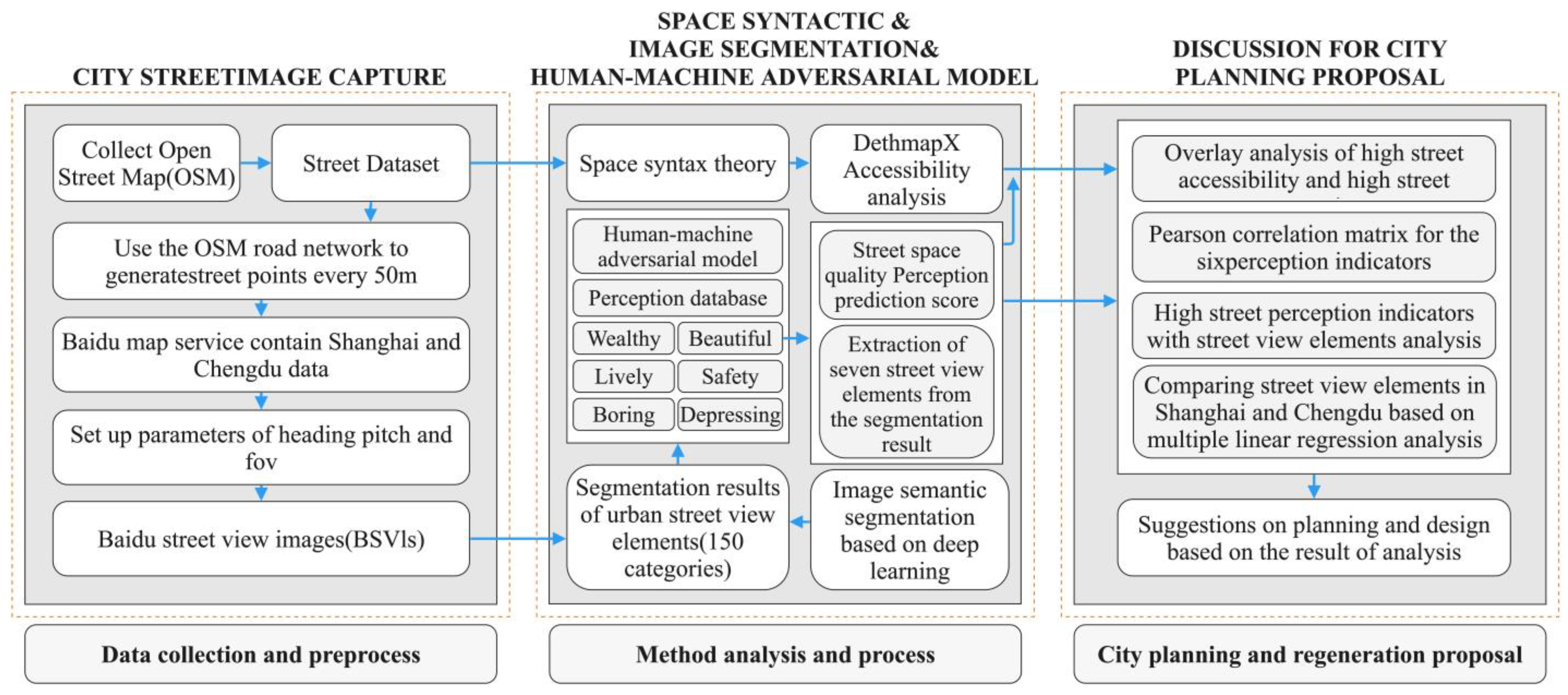
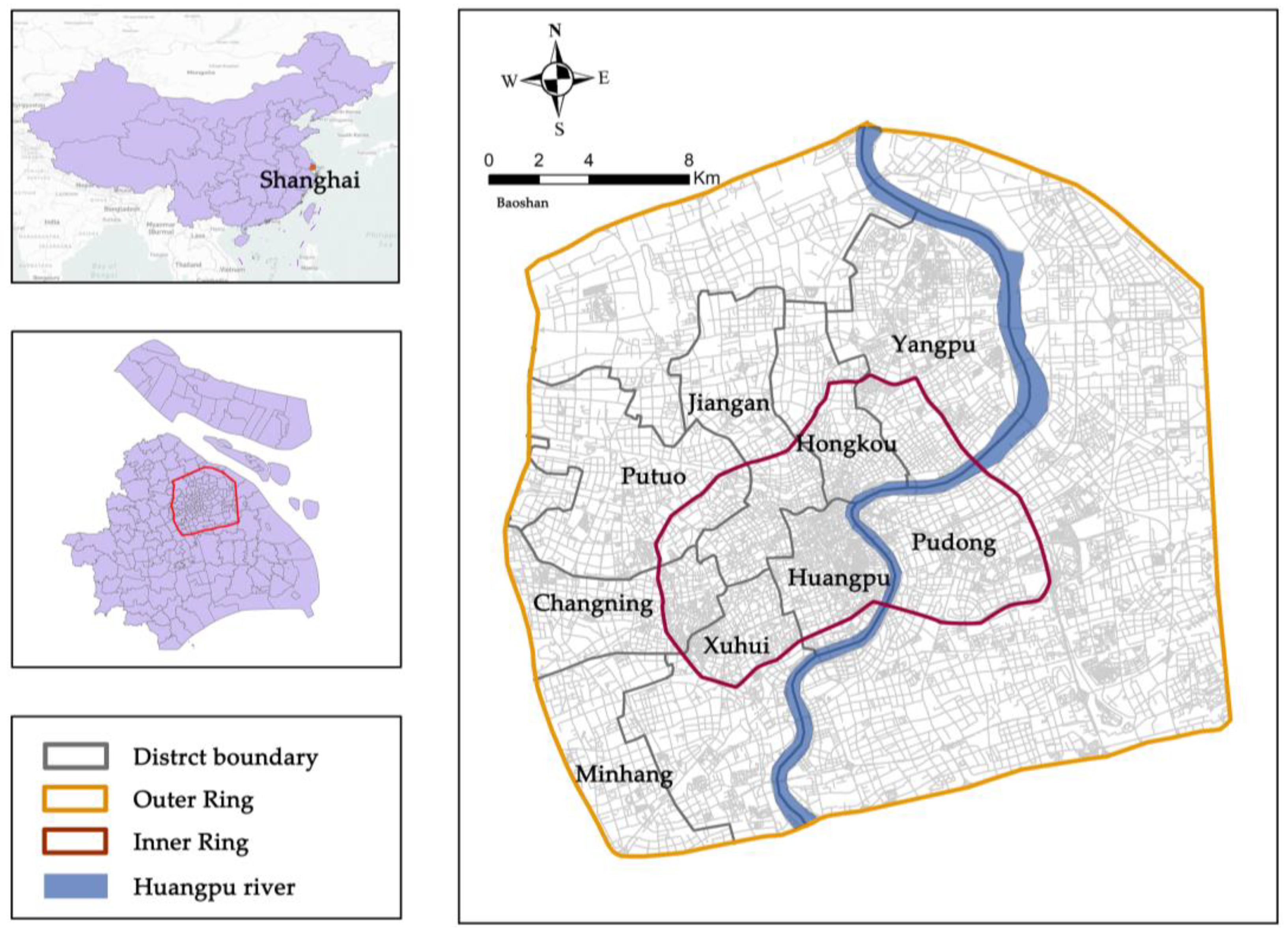


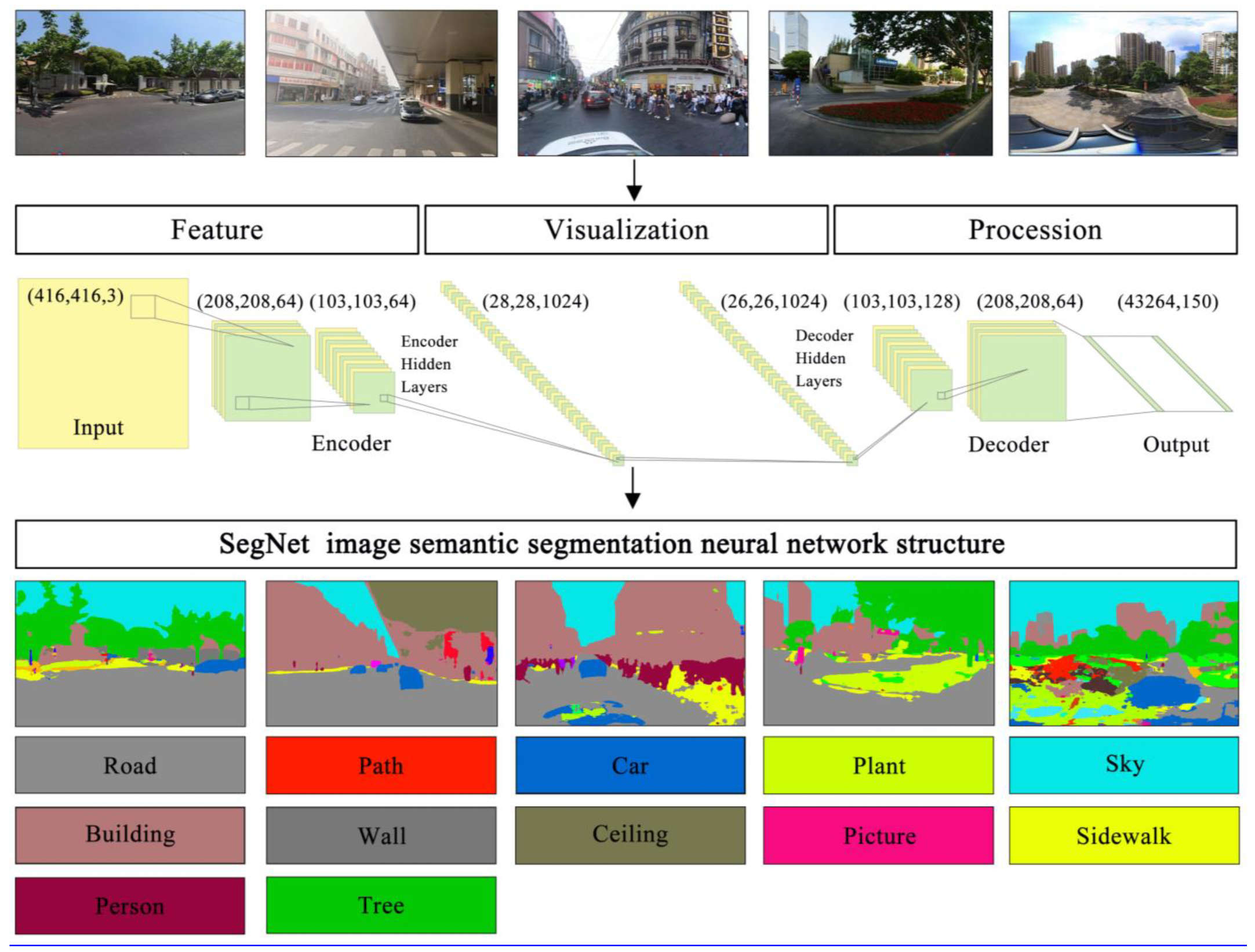
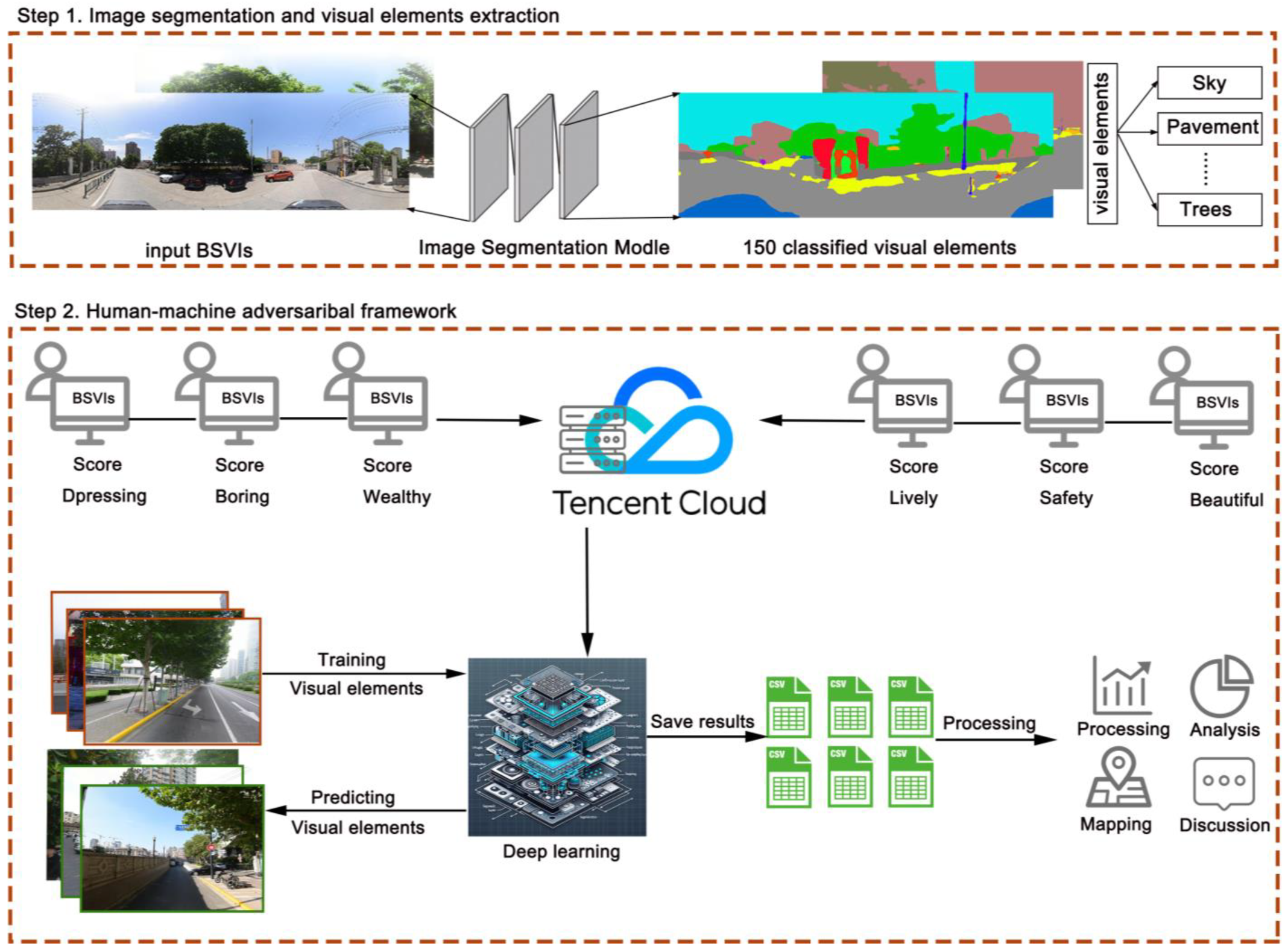
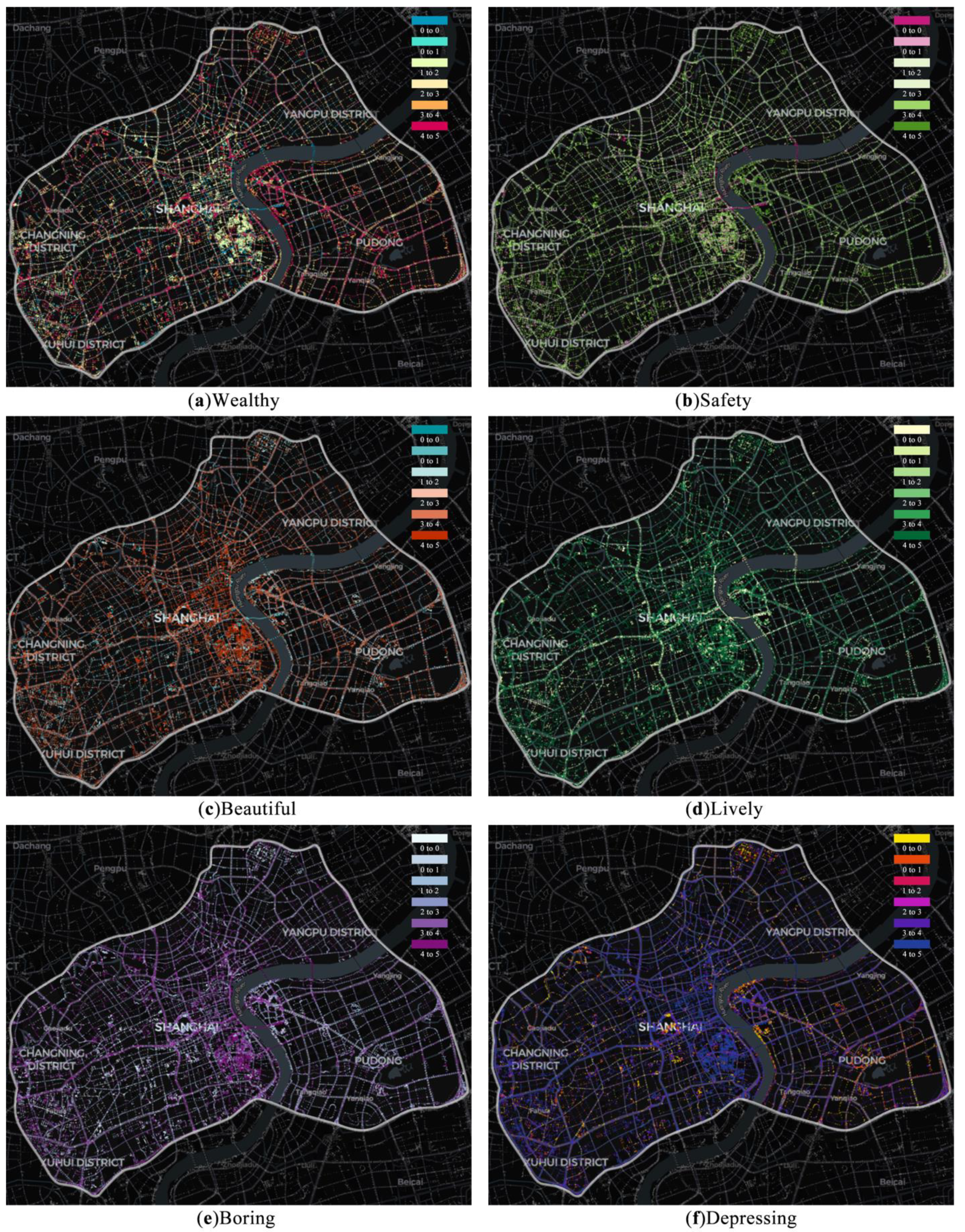
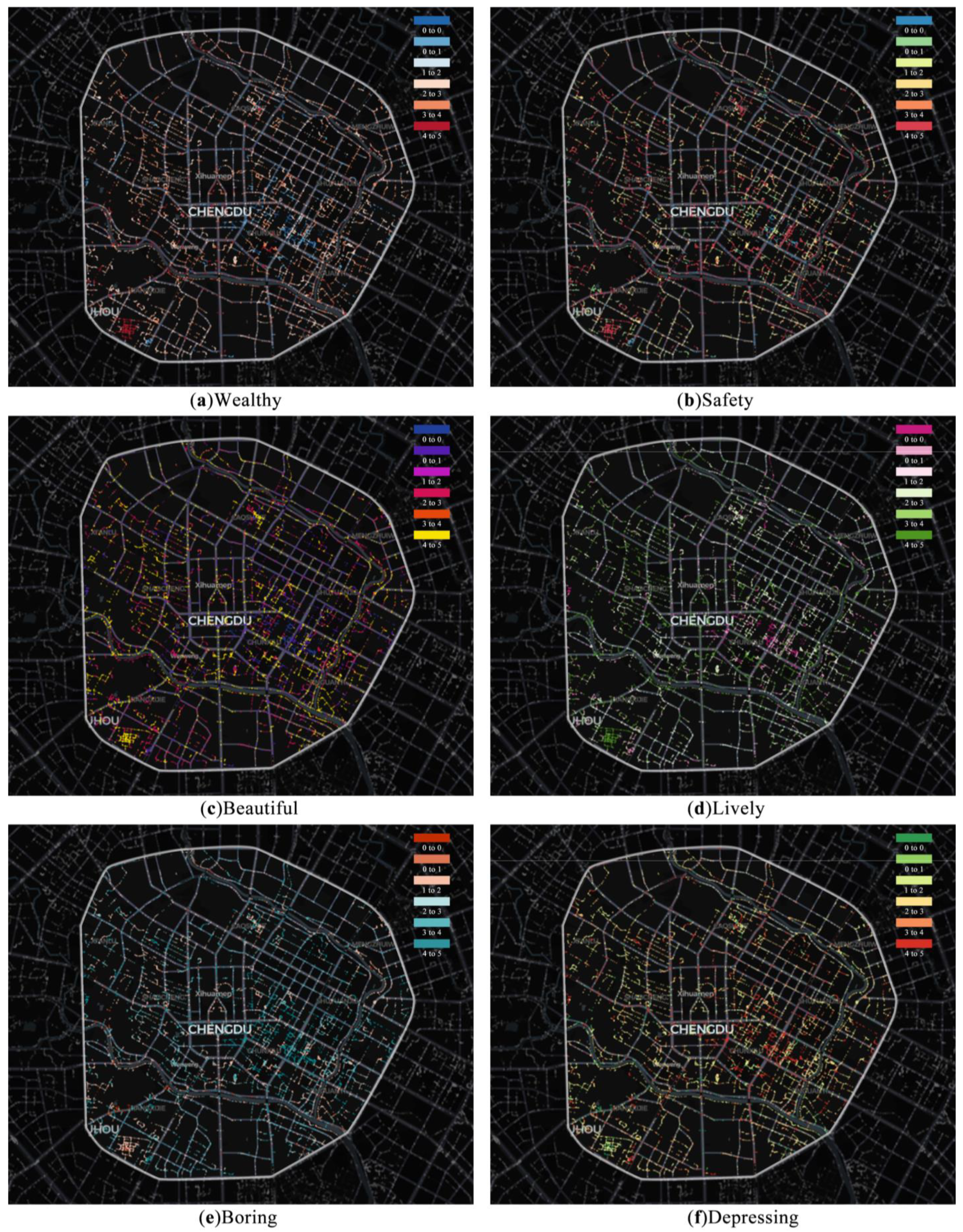
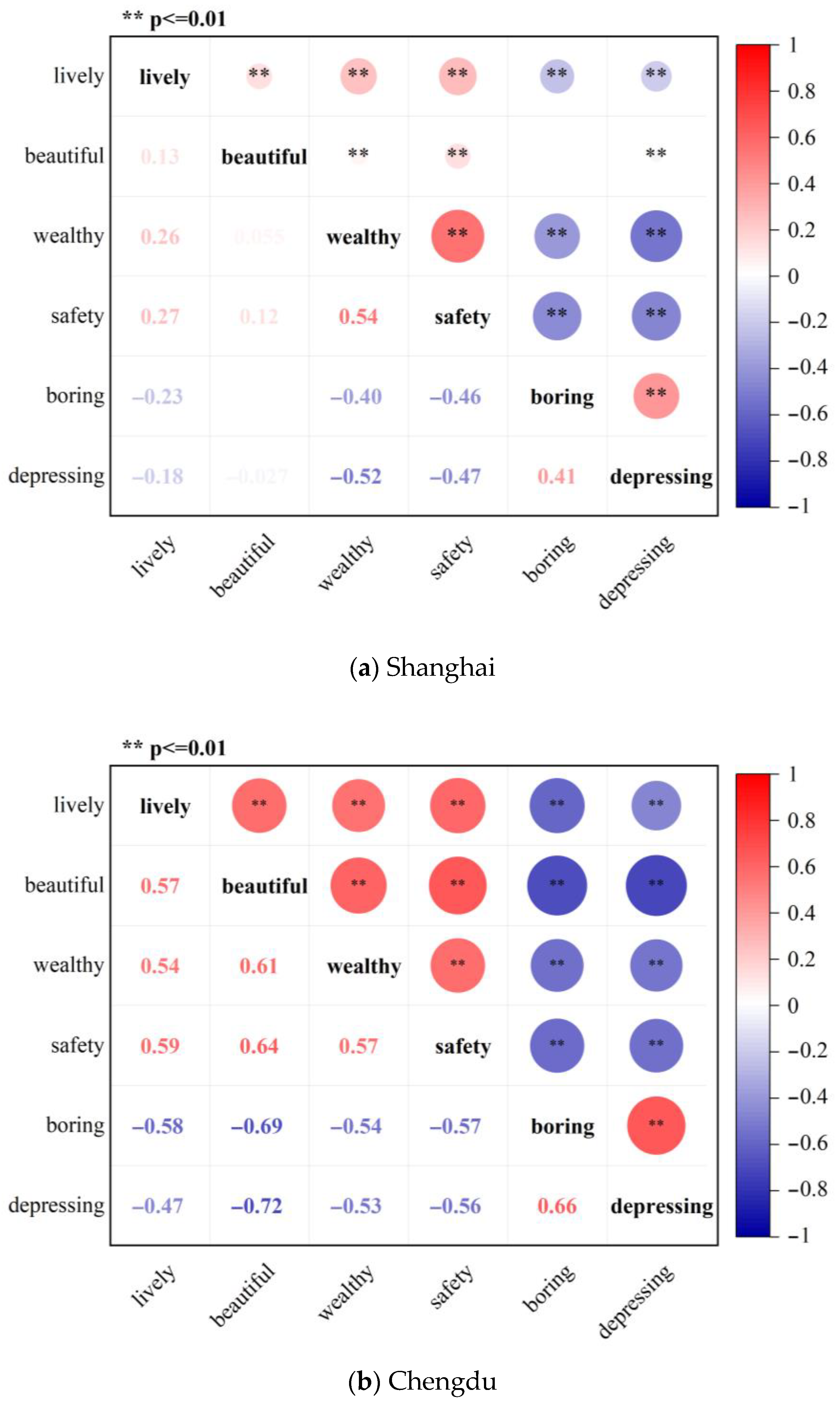
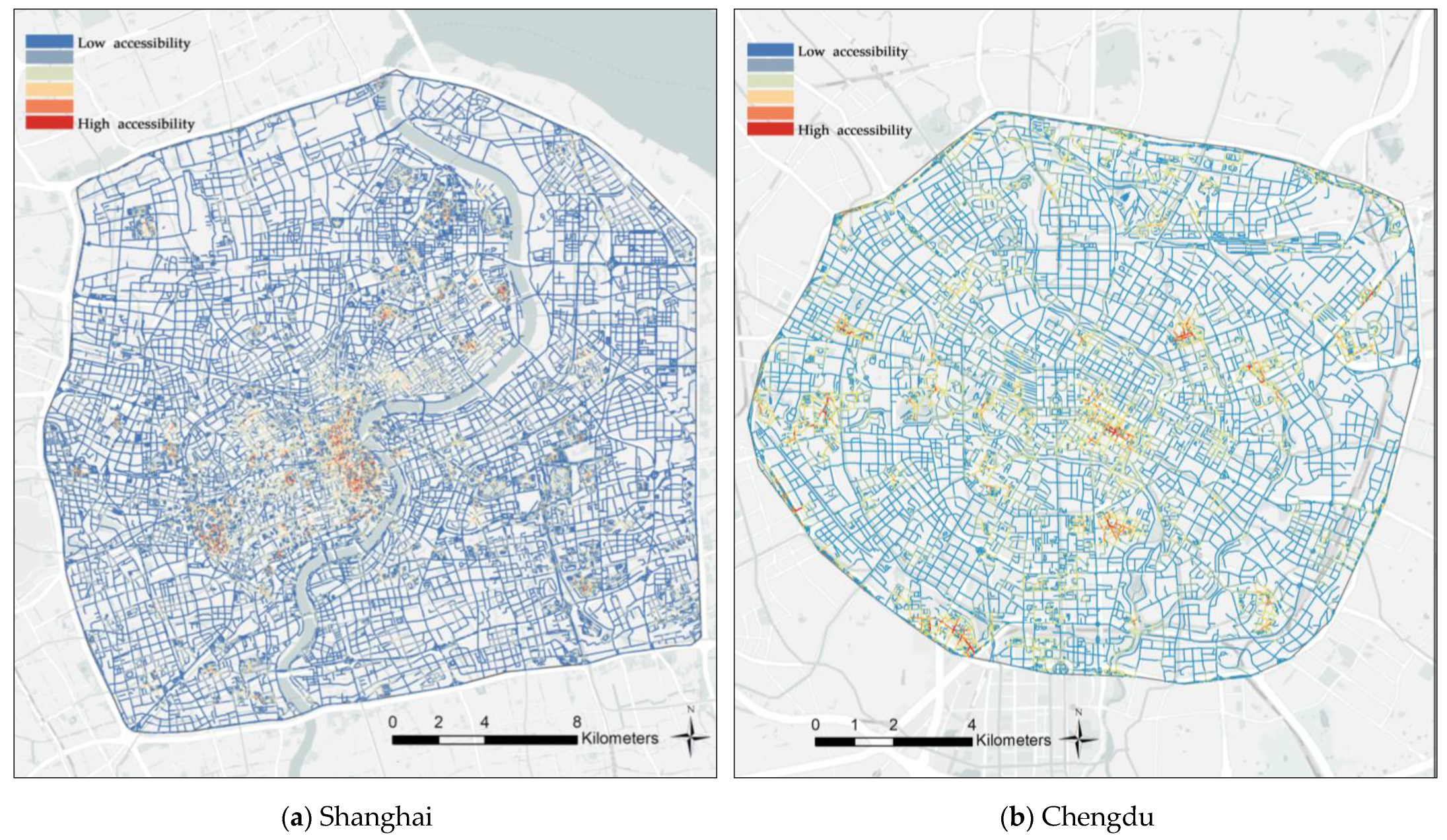
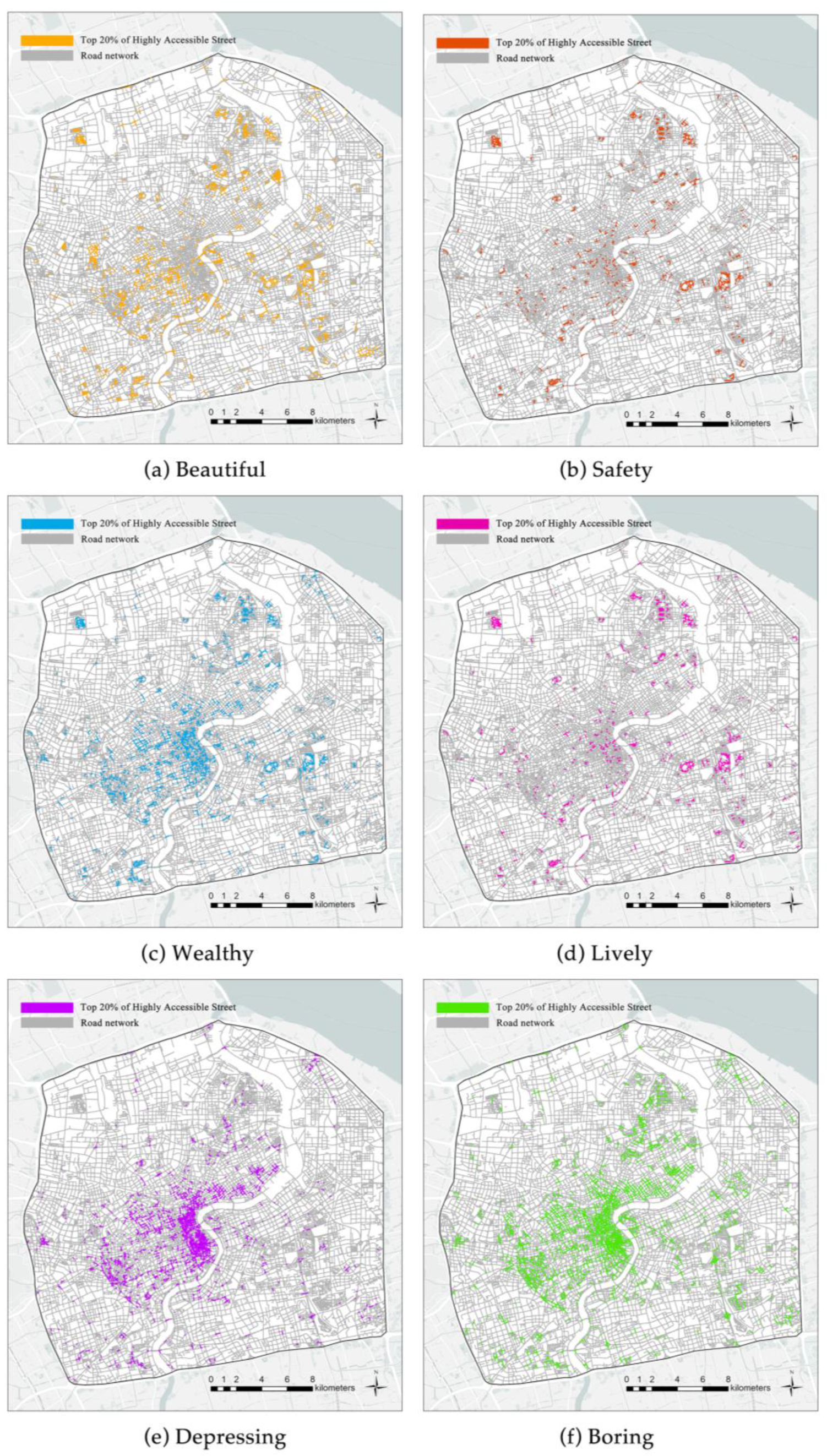


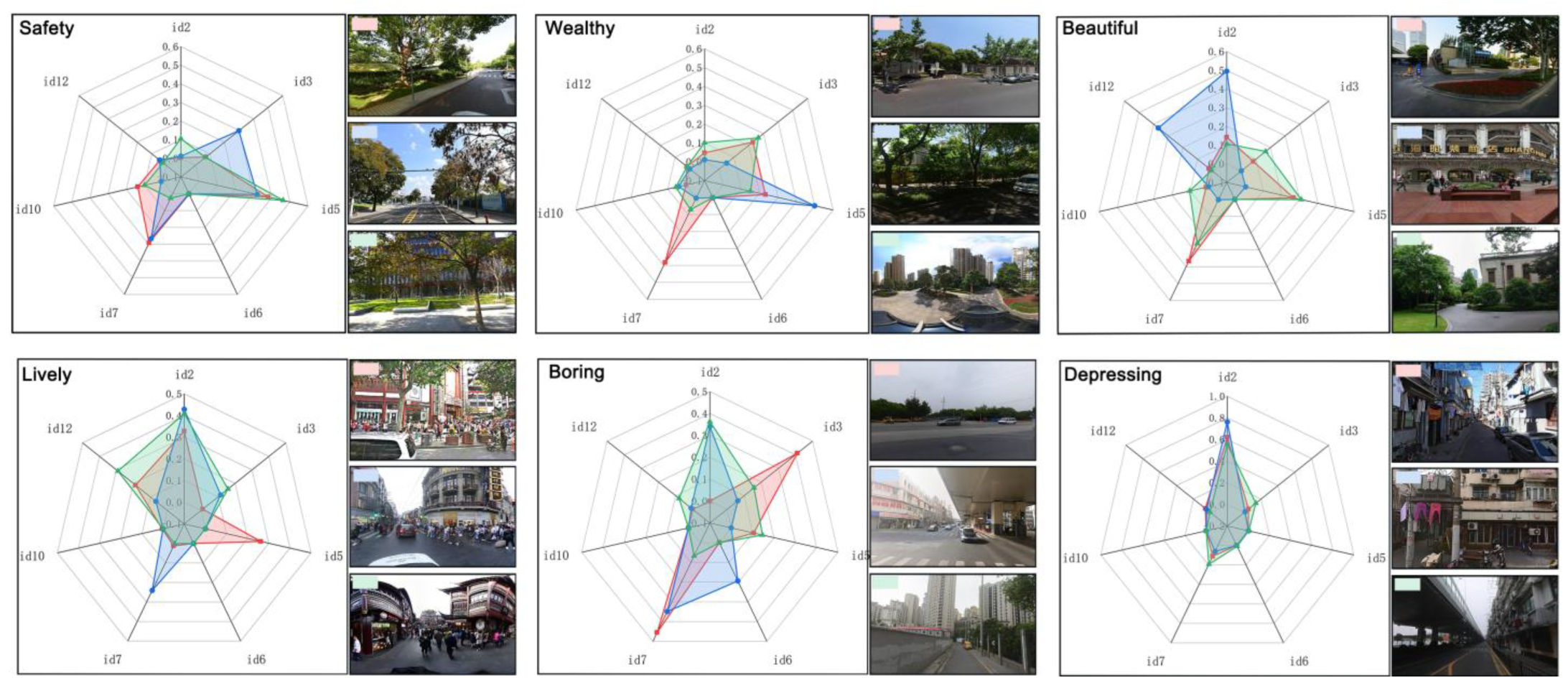
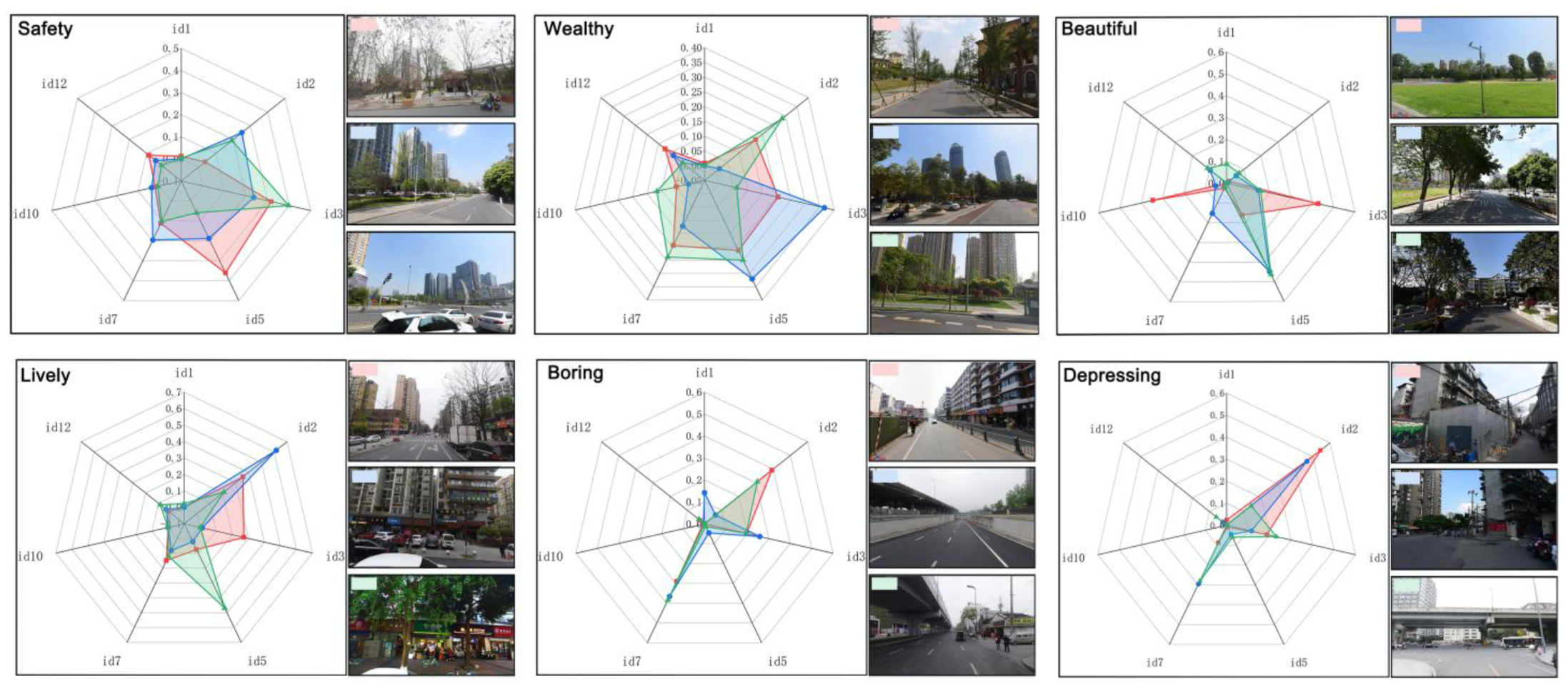
| Perception | Precision | Recall | F1-Score | Accuracy | OOB Error |
|---|---|---|---|---|---|
| Boring | 0.88 | 0.83 | 0.87 | 0.90 | 0.18 |
| Depressing | 0.62 | 0.60 | 0.56 | 0.61 | 0.40 |
| Lively | 0.73 | 0.64 | 0.62 | 0.66 | 0.40 |
| Wealthy | 0.64 | 0.60 | 0.71 | 0.63 | 0.42 |
| Safety | 0.63 | 0.60 | 0.60 | 0.66 | 0.46 |
| Beautiful | 0.93 | 0.89 | 0.88 | 0.89 | 0.17 |
| Perception | Precision | Recall | F1-Score | Accuracy | OOB Error |
|---|---|---|---|---|---|
| Wealthy | 0.85 | 0.85 | 0.86 | 0.85 | 0.24 |
| Beautiful | 0.83 | 0.83 | 0.85 | 0.85 | 0.24 |
| Depressing | 0.87 | 0.87 | 0.86 | 0.87 | 0.23 |
| Lively | 0.89 | 0.86 | 0.87 | 0.87 | 0.22 |
| Safety | 0.85 | 0.85 | 0.85 | 0.85 | 0.24 |
| Boring | 0.86 | 0.85 | 0.85 | 0.88 | 0.19 |
| Number | Visual Elements | Min | Max | Mean | S.D. |
|---|---|---|---|---|---|
| id3 | Sky | 0.001 | 0.911 | 0.293 | 0.119 |
| id7 | Road | 0.001 | 0.473 | 0.230 | 0.088 |
| id5 | Tree | 0.001 | 0.769 | 0.114 | 0.099 |
| id2 | Building | 0.001 | 0.782 | 0.093 | 0.090 |
| id12 | Pavement | 0.001 | 0.454 | 0.028 | 0.038 |
| id6 | Ceiling | 0.001 | 0.696 | 0.021 | 0.073 |
| id10 | Wall | 0.001 | 0.628 | 0.012 | 0.034 |
| Number | Visual Elements | Min | Max | Mean | S.D. |
|---|---|---|---|---|---|
| id3 | Sky | 0.001 | 0.665 | 0.227 | 0.138 |
| id2 | Building | 0.001 | 0.877 | 0.221 | 0.160 |
| id5 | Tree | 0.001 | 0.793 | 0.203 | 0.147 |
| id7 | Road | 0.001 | 0.423 | 0.145 | 0.077 |
| id12 | Pavement | 0.001 | 0.342 | 0.047 | 0.043 |
| id1 | Wall | 0.001 | 0.759 | 0.026 | 0.052 |
| id10 | grass | 0.001 | 0.350 | 0.022 | 0.040 |
| Sky | Road | Tree | Building | Pavement | Ceiling | Wall | |
|---|---|---|---|---|---|---|---|
| Beautiful | 0.254 | 0.246 | 0.106 | 0.165 | 0.03 | 0 | 0.049 |
| Boring | 0.287 | 0.229 | 0.069 | 0.141 | 0.033 | 0 | 0.015 |
| Depressing | 0.233 | 0.216 | 0.034 | 0.218 | 0.04 | 0.042 | 0.021 |
| Lively | 0.165 | 0.227 | 0.174 | 0.179 | 0.039 | 0 | 0.006 |
| Wealthy | 0.257 | 0.232 | 0.247 | 0.114 | 0.035 | 0 | 0.006 |
| Safety | 0.221 | 0.246 | 0.159 | 0.136 | 0.044 | 0 | 0.009 |
| Sky | Building | Tree | Road | Pavement | Wall | Grass | |
|---|---|---|---|---|---|---|---|
| Boring | 0.319 | 0.245 | 0.064 | 0.166 | 0.022 | 0.043 | 0.015 |
| Depressing | 0.288 | 0.248 | 0.101 | 0.173 | 0.033 | 0.036 | 0.013 |
| Lively | 0.201 | 0.226 | 0.232 | 0.142 | 0.053 | 0.011 | 0.038 |
| Wealthy | 0.256 | 0.111 | 0.272 | 0.151 | 0.042 | 0.009 | 0.074 |
| Safety | 0.232 | 0.206 | 0.217 | 0.14 | 0.052 | 0.015 | 0.036 |
| Beautiful | 0.219 | 0.189 | 0.14 | 0.067 | 0.034 | 0.026 | 1.459 |
| Standardization Factor | Beautiful (Beta) | Lively (Beta) | Wealthy (Beta) | Safety (Beta) | Boring (Beta) | Depressing (Beta) |
|---|---|---|---|---|---|---|
| Sky | −0.046 *** | −0.003 | 0.458 *** | −0.061 *** | 0.086 *** | −0.175 *** |
| road | 0.032 *** | 0.026 *** | −0.013 *** | −0.052 *** | −0.001 | −0.004 * |
| Tree | −0.095 *** | −0.071 *** | 0.689 *** | 0.397 *** | −0.380 *** | −0.521 *** |
| building | 0.120 *** | 0.102 *** | 0.178 *** | 0.048 *** | −0.007 *** | 0.177 *** |
| pavement | −0.041 *** | −0.025 *** | −0.109 *** | 0.002 | −0.014 *** | −0.090 *** |
| ceiling | −0.167 *** | −0.270 *** | 0.013 | −0.272 *** | 0.257 *** | 0.236 *** |
| wall | −0.129 *** | −0.281 *** | −0.057 *** | −0.182 *** | 0.030 *** | 0.006 ** |
| Standardization Factor | Beautiful (Beta) | Lively (Beta) | Wealthy (Beta) | Safety (Beta) | Boring (Beta) | Depressing (Beta) |
|---|---|---|---|---|---|---|
| Sky | −0.032 *** | −0.025 *** | 0.069 *** | 0.051 *** | 0.047 *** | 0.037 *** |
| Building | −0.092 *** | 0.106 *** | −0.053 *** | −0.014 | −0.039 *** | 0.099 *** |
| Tree | 0.321 *** | 0.305 *** | 0.260 *** | 0.134 *** | −0.354 *** | −0.302 *** |
| Road | −0.011 ** | 0.242 *** | 0.119 *** | 0.117 *** | −0.076 *** | 0.067 *** |
| Pavement | 0.158 *** | 0.253 *** | 0.204 *** | 0.273 *** | −0.150 *** | −0.133 *** |
| Wall | −0.143 *** | −0.080 *** | −0.064 *** | −0.148 *** | 0.095 *** | 0.136 *** |
| grass | 0.158 *** | 0.235 *** | 0.377 *** | 0.271 *** | −0.217 *** | −0.168 *** |
Disclaimer/Publisher’s Note: The statements, opinions and data contained in all publications are solely those of the individual author(s) and contributor(s) and not of MDPI and/or the editor(s). MDPI and/or the editor(s) disclaim responsibility for any injury to people or property resulting from any ideas, methods, instructions or products referred to in the content. |
© 2024 by the authors. Licensee MDPI, Basel, Switzerland. This article is an open access article distributed under the terms and conditions of the Creative Commons Attribution (CC BY) license (https://creativecommons.org/licenses/by/4.0/).
Share and Cite
Lei, Y.; Zhou, H.; Xue, L.; Yuan, L.; Liu, Y.; Wang, M.; Wang, C. Evaluating and Comparing Human Perceptions of Streets in Two Megacities by Integrating Street-View Images, Deep Learning, and Space Syntax. Buildings 2024, 14, 1847. https://doi.org/10.3390/buildings14061847
Lei Y, Zhou H, Xue L, Yuan L, Liu Y, Wang M, Wang C. Evaluating and Comparing Human Perceptions of Streets in Two Megacities by Integrating Street-View Images, Deep Learning, and Space Syntax. Buildings. 2024; 14(6):1847. https://doi.org/10.3390/buildings14061847
Chicago/Turabian StyleLei, Yalun, Hongtao Zhou, Liang Xue, Libin Yuan, Yigang Liu, Meng Wang, and Chuan Wang. 2024. "Evaluating and Comparing Human Perceptions of Streets in Two Megacities by Integrating Street-View Images, Deep Learning, and Space Syntax" Buildings 14, no. 6: 1847. https://doi.org/10.3390/buildings14061847





